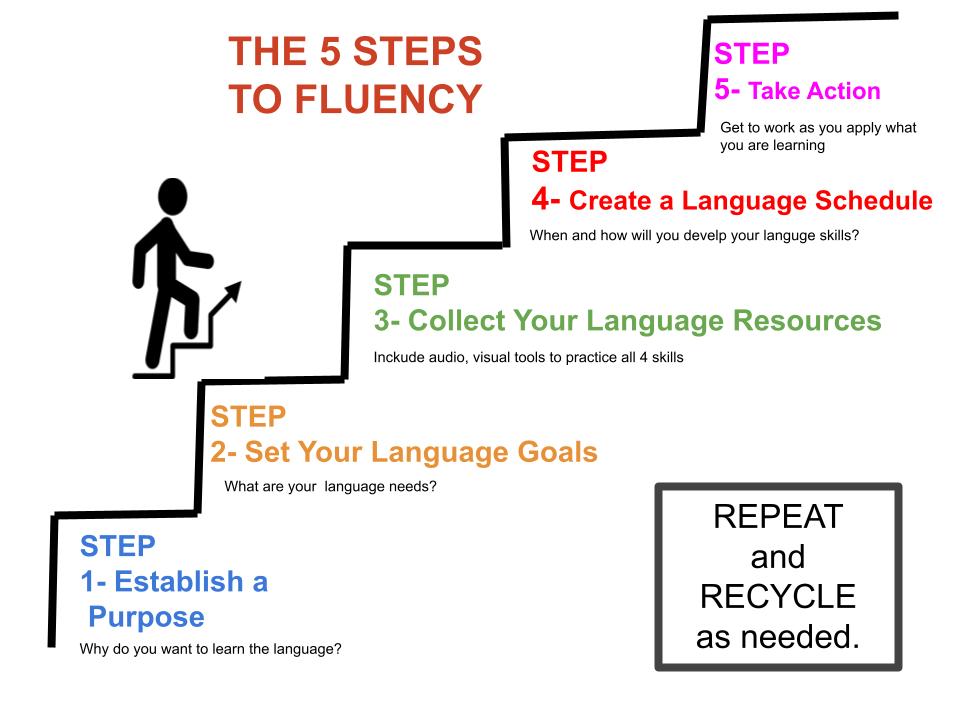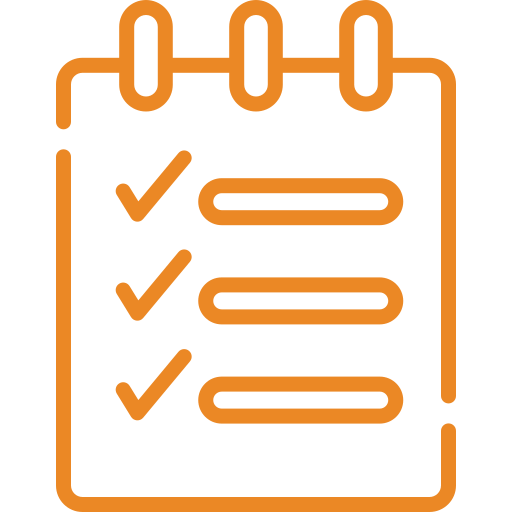Getting Started
What is your language mindset?
1st. Examine Your Language Mindset
I don’t know where to begin in the foreign language learning process.
There is no magic bullet when it comes to learning a second language. Although babies can naturally pick up language without any formal planning or preparation, this is not the case for adults.
Adults or expats can reach fluency in another language by setting language goals, proper planning, and the right mindset. If you are intentional you will be a more effective language learner and reach fluency faster.

2nd- Ask Yourself These Questions Before Diving Into
Learning a New Language
1. Why do I want to learn the language?
2. What will I do with my language skills?
3. How similar is the target language to my native language? For example,
Spanish in many ways is similar to English due to the Latin and Greek
influences. Japanese, on the other hand, is quite different and therefore difficult
to learn for an English-speaker.
4. How complex is the target language? For example, if you are learning
Japanese, you will have to learn three different writing systems and at least 200
kanji in order to be able to function on a basic level. On the other hand, French,
for example, shares a similar writing system as English making learning French a
lot easier.
5. How much time and effort can I devote to learning the language? According to
the Foreign Service Institute, Japanese requires approximately 2,200 hours to
become proficient while Spanish only 600 hours,
6. How available are the language learning resources? There are more resources
on the market for Spanish than there are for Swahili, for example.
7. How motivated am I to learn this language? How badly do I want to be fluent?
8. Will I be able to maintain the language? Remember,”You’ll lose it if you don’t
use it? Opportunities for practice are a must.
9. With whom will I practice the language? Will you have neighbors?
Maybe a partner or the other members of the yoga club?
10. Where will I practice the language? Think of the places you will frequent.
11. What skill level am I aiming for? Do I just want to speak at a basic level and
just be able “to get by” or do I want to speak on an advanced level and be
able to function in most settings, including understanding local TV programs,
and being able to read the local newspaper?
You will be a more effective language learner if you ask yourself the questions
You will be a more effective language learner if you ask yourself the questions
above and follow the following steps on your journey to becoming fluent.


Setting Language Goals and Language Planning
Do You Have a Language Goal?
Do You Have a Language Plan?
5 Step Plan


Step 1
Establish Your Purpose
Ask yourself these questions:
Why do you want to learn this language?
What are you going to do with this language?
Who are you?
- Are you a retiree or snow bird who simply wants conversational language in order to be able to order at a restaurant and go shopping?
- Are you a restaurant owner and want to be able to use business language and communicate with employees?
- Are you a digital nomad who will be living in the country temporarily and simply want to be able to get by with transactional language?
Once you establish a purpose for learning the language you can then begin the planning process and create a plan for your purpose. Additionally, you will be a more effective language learner and have a better sense of accomplishment..

Step 2
Set Realistic Language Goals
Very little is accomplished without setting goals, realistic goals. Goal setting will help you stay focused and stay on track. Make short term goals first.
Determine Your Language Needs
How Fluent Do You Want to Be?
Ask Yourself….
Do you I want to be able to:
order at a restaurant
chat with neighbors and the locals
read the local newspaper
attend the local university where the language of instruction is a foreign language
become a citizen or permanent resident

Step 3
Identify and Collect Resources
You will need to invest in language tools that will allow you to practice the following skills:
- speaking
- reading
- writing
- listening
There are many language learning products and services on the market, especially for Spanish-language learners. Here are some recommendations
Here is a list of foreign language learning tools and resources you may want to consider:
- DIGITAL PRODUCTS
- Podcasts
- Apps
- DvDs/Learn in your car
- Websites
- Blogs
- Youtube Channels
- Online Dictionaries
- Online Translators
- Online Programs
- Online Colleges and Universities
- PRINT PRODUCTS
- Foreign language Reference or Study Guide Books (grammar, vocabulary)
- Textbooks
- Dictionaries
- IN PERSON
- Classes
- Tutor
- Language Cafe

Step 4
Create a schedule
When will you receive instruction in the language?
→ Will you learn a certain amount of words/phrases per day?
→ Will you be self-taught and study on your own by using online apps such as Duolingo or Learn in your car CDs?
→ Will you enroll in an in class program or online program?
→ Will you take a weekly course or a semester course?
→ Will you hire a private tutor twice a week or once a month?
→ Will you go abroad and learn the language in a language immersion program?
Perhaps it is a combination of these things.
I suggest you come up with a realistic study schedule that fits your needs, budget, lifestyle and try to commit to it. You can use a planner or planner app to keep you organized and focused.
Don’t make the mistake of thinking that you will have time. You will have to carve out time and dedicate some of your day to language learning. Whichever schedule you choose, please make time to record your progress in a journal. I have several types of foreign language journals for sale on Amazon.com.

Step 5
Take Action
After you have gone through the steps having:
→ Established a purpose
→ Created a language plan
→ Collected your language resources and tools
→ Created a language schedule
Now, it is time to TAKE ACTION.
Having the most expensive language tools and attending the best language program will not be enough to make you fluent. You must study hard and apply what you have learned in the textbook in the real world. There is a saying, “You learn by doing.” Each time you participate in a cultural event or engage with a loca,l you will improve not only your language skills, but your understanding of the culture.
How do you take action?
1. Be date-specific.
For example,
On July 1, I will start my Italian Conversation class;
Next week, I will make flashcards of food vocabulary;
On Mondays and Wednesdays I will work with a tutor;
Everyday I will spend 15 minutes learning Italian on Duolingo.
2.Take the initiative to apply what you have learned. Don’t wait for anyone (your tutor,
etc. ) to present the opportunity. You can take dance lessons, join a sports team, join a gym, etc. This way you are assimilating into the culture and making new friends while practicing your language skills
3.. Be brave and take chances and get out of your language comfort zone.
4.. Don’t be afraid to make mistakes.
5. Don’t feel ashamed to sound ‘silly’ when speaking the language.
6. As it relates to language learning, your ego is not your amigo.

